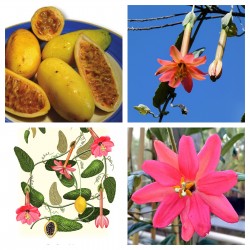Menu
-
MenuBack
- Home
-
Categories
-
-
Categories
-
Vegetable Seeds
-
Varieties by Country
- Varieties from Armenia
- Varieties from BiH
- Varieties from Croatia
- Varieties from France
- Varieties from Germany
- Varieties from Greece
- Varieties from Hungary
- Varieties from India
- Varieties from Italy
- Varieties from Japan
- Varieties from North Macedonia
- Varieties from Peru
- Varieties from Russia
- Varieties from Serbia
- Varieties from Slovenia
- Varieties from Spain
- Varieties from Thailand
- Varieties from Turkey
- Varieties from USA
- Tomato Seeds
- Corn Seeds
- Gourd family
- Bean family
- Cucumber Seeds
- Pepper Seeds
- Carrot family
- Onion family
- Lettuce Seeds
- Potato family
- Cabbage family
- Radish Seeds
- Beetroot family
- Watermelon Seeds
- Melon Seeds
- Cauliflower Seeds
- Sunflower family
-
Varieties by Country
- Fruit Seeds
- Chili - Habanero Seeds
- Medicinal Herb Seeds
- Climbing Plants Seeds
- Trees Bonsai Seeds
- Palm Seeds
- Ornamental Grasses Seeds
- Tobacco Seeds
-
Vegetable Seeds
-
-
-
-
- NEW PRODUCTS
- Create account
- Delivery - Payment
- FAQ
- Home
-
- Large Packets of Seeds
- Giant Plants Seeds
- Vegetable Seeds
- Varieties by Country
- Varieties from Armenia
- Varieties from BiH
- Varieties from Croatia
- Varieties from France
- Varieties from Germany
- Varieties from Greece
- Varieties from Hungary
- Varieties from India
- Varieties from Italy
- Varieties from Japan
- Varieties from North Macedonia
- Varieties from Peru
- Varieties from Russia
- Varieties from Serbia
- Varieties from Slovenia
- Varieties from Spain
- Varieties from Thailand
- Varieties from Turkey
- Varieties from USA
- Tomato Seeds
- Corn Seeds
- Gourd family
- Bean family
- Cucumber Seeds
- Pepper Seeds
- Carrot family
- Onion family
- Lettuce Seeds
- Potato family
- Cabbage family
- Radish Seeds
- Beetroot family
- Watermelon Seeds
- Melon Seeds
- Cauliflower Seeds
- Sunflower family
- Varieties by Country
- Fruit Seeds
- Chili - Habanero Seeds
- Medicinal Herb Seeds
- Climbing Plants Seeds
- Trees Bonsai Seeds
- Banana Seeds
- Palm Seeds
- Ornamental Grasses Seeds
- Tobacco Seeds
- Flower Seeds
- Cactus Seeds
- Water plants seeds
- Sowing Instructions
- Fruit and vegetable molds
- Mushroom Mycelium
- Plant Bulbs
- Bamboo seeds
- Ayurveda Plants
- F1 Hybrid Seeds
- Packaging and stuff
- Cold-resistant plants
- Plants Care
- Organic Spices
- Delivery - Payment
- No PayPal and Card payment X
Last Product Reviews
Out of the two seeds, one germinated and the other one was dead and floatin...
By
 Riikka H on 07/03/2024
Riikka H on 07/03/2024
Verified Purchase
Best sellers
There are 1290 products.
Showing 556-570 of 1290 item(s)

Medicinal or spice plant
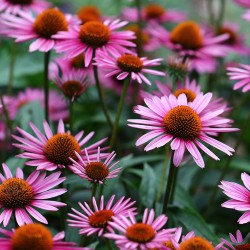
Purple coneflower seeds...
Price
€1.15
(SKU: MHS 75)
Seeds Gallery EU,
5/
5
<h2><strong>Purple coneflower seeds (Echinacea purpurea)</strong></h2>
<h2><span style="color: #ff0000;"><strong>Price for a Package of 20 seeds.</strong></span></h2>
<p style="color: #202122; font-size: 14px;"><i><b>Echinacea purpurea</b></i>, the<span> </span><b>eastern purple coneflower</b>,<sup id="cite_ref-b_2-0" class="reference" style="font-size: 11.2px;"></sup><span> </span><b>purple coneflower</b>,<span> </span><b>hedgehog coneflower</b>, or<span> </span><b>echinacea</b>, is a<span> </span>North American<span> </span>species<span> </span>of<span> </span>flowering plant<span> </span>in the<span> </span>sunflower family.<sup id="cite_ref-Zimmerman_3-0" class="reference" style="font-size: 11.2px;"></sup><span> </span>It is<span> </span>native<span> </span>to parts of eastern North America<sup id="cite_ref-pfaf_4-0" class="reference" style="font-size: 11.2px;"></sup><span> </span>and presents to some extent in the wild in much of the eastern, southeastern, and midwestern<span> </span>United States<span> </span>as well as in the<span> </span>Canadian Province<span> </span>of<span> </span>Ontario. It is most common in the<span> </span>Ozarks<span> </span>and in the<span> </span>Mississippi/Ohio Valley. <sup id="cite_ref-PLANTS_5-0" class="reference" style="font-size: 11.2px;"></sup><sup id="cite_ref-6" class="reference" style="font-size: 11.2px;"></sup>Its<span> </span>habitats<span> </span>include dry open woods, prairies, and barrens.</p>
<h2 style="color: #000000; font-size: 1.5em;"><span class="mw-headline" id="Taxonomy">Taxonomy</span></h2>
<p><i>Echinacea</i><span> </span>is derived from<span> </span>Greek, meaning ‘spiny one’, in reference to the spiny sea urchins 'εχίνοι' which the ripe flower heads of species of this genus resemble. The epithet<span> </span><i>purpurea</i><span> </span>means 'reddish-purple'.<sup id="cite_ref-gledhill_7-0" class="reference" style="font-size: 11.2px;">[7]</sup><span> </span>Originally named<span> </span><i>Rudbeckia purpurea</i><span> </span>by Linnaeus in 1753 in Species plantarum 6, it was reclassified in 1794 by Conrad Moench, in a new genus named<span> </span><i>Echinacea purpurea</i><span> </span>(L.) Moench. In 1818,<span> </span>Thomas Nuttall<span> </span>describes a new variety that he named<span> </span><i>Rudbeckia purpurea</i><span> </span>var. serotina. Just two decades later, De Candolle raised him to the rank of species of the other genus<span> </span><i>Echinacea serotina</i><span> </span>(Nutt.) DC. (1836).<sup id="cite_ref-8" class="reference" style="font-size: 11.2px;">[8]</sup><span> </span>In 2002, Binns et al. discovered a misapplication of the name<span> </span><i>Echinacea purpurea</i><span> </span><span style="font-size: 11.9px;">(L.) Moench</span><span> </span>for the taxon correctly named<span> </span><i>Echinacea serotina</i><span> </span><span style="font-size: 11.9px;">(Nutt.) DC.</span><span> </span>in 1836. The authors proposed to retain the names not to cause confusion among gardeners and herbalists.<sup id="cite_ref-9" class="reference" style="font-size: 11.2px;">[9]</sup><span> </span>Other names include: Broad-leaved purple coneflower, Eastern Purple Coneflower, Hedgehog Coneflower, Echinacea.</p>
<h2 style="color: #000000; font-size: 1.5em;"><span class="mw-headline" id="Description">Description</span></h2>
<p><i>Echinacea purpurea</i><span> </span>is an<span> </span>herbaceous<span> </span>perennial<span> </span>up to 120 cm (47 in) tall by 25 cm (10 in) wide at maturity. Depending on the climate, it blooms throughout summer into autumn. Its cone-shaped<span> </span>flowering heads<span> </span>are usually, but not always, purple in the wild. Its individual flowers (florets) within the<span> </span>flower head<span> </span>are<span> </span>hermaphroditic, having both male and female organs in each flower. It is<span> </span>pollinated<span> </span>by butterflies and bees. The alternate leaves, borne by a<span> </span>petiole<span> </span>from 0 to 17 cm, are oval to<span> </span>lanceolate, 5-30 x 5-12 cm; the margin is tightened to toothed.</p>
<p>The<span> </span>inflorescence<span> </span>is a<span> </span>capitulum, 7 to 15 cm in diameter, formed by a prominent domed central protuberance consisting of multiple small yellow florets. These are surrounded by a ring of pink or purple<span> </span>ligulate<span> </span>florets. The tubular florets are<span> </span>hermaphrodite<span> </span>while the ligular florets are<span> </span>sterile. The<span> </span>involucral bracts<span> </span>are linear to lanceolate. The plant prefers well-drained soils in full sun.<sup id="cite_ref-b_2-1" class="reference" style="font-size: 11.2px;">[2]</sup><span> </span>The fruit is an<span> </span>achene, sought after by birds.</p>
<h2 style="color: #000000; font-size: 1.5em;"><span class="mw-headline" id="Cultivation">Cultivation</span></h2>
<p style="color: #202122; font-size: 14px;"><i>Echinacea purpurea</i><span> </span>is grown as an<span> </span>ornamental plant<span> </span>in temperate regions. It is ideal for curbs, walkways or beds. The flowers can also go into the composition of fresh bouquets. Numerous<span> </span>cultivars<span> </span>have been developed for flower quality and plant form.<sup id="cite_ref-Zimmerman_3-1" class="reference" style="font-size: 11.2px;">[3]</sup><span> </span>The plant grows in sun or light shade.<sup id="cite_ref-midgely1999_10-0" class="reference" style="font-size: 11.2px;">[10]</sup><span> </span>It thrives in either dry or moist soil and can tolerate drought once established. The cultivars 'Ruby Giant'<sup id="cite_ref-11" class="reference" style="font-size: 11.2px;">[11]</sup><span> </span>and<span> </span><span class="trade_designation"><b>Elton Knight</b></span>='Elbrook'<sup id="cite_ref-12" class="reference" style="font-size: 11.2px;">[12]</sup><span> </span>have gained the<span> </span>Royal Horticultural Society's<span> </span>Award of Garden Merit.<sup id="cite_ref-13" class="reference" style="font-size: 11.2px;">[13]</sup></p>
<h3 style="color: #000000; font-size: 1.2em;"><span class="mw-headline" id="Propagation">Propagation</span></h3>
<p style="color: #202122; font-size: 14px;"><i>Echinacea purpurea</i><span> </span>is<span> </span>propagated<span> </span>either<span> </span>vegetatively<span> </span>or from<span> </span>seeds.<sup id="cite_ref-pfaf_4-1" class="reference" style="font-size: 11.2px;">[4]</sup><span> </span>Useful vegetative techniques include division, root cuttings, and basal cuttings. Clumps can be<span> </span>divided, or broken into smaller bunches, which is normally done in the spring or autumn. Cuttings made from roots that are "pencil-sized" will develop into plants when started in late autumn or early winter.<sup id="cite_ref-Zimmerman_3-2" class="reference" style="font-size: 11.2px;">[3]</sup><span> </span>Cuttings of basal shoots in the spring may be rooted when treated with<span> </span>rooting hormones, such as IBA at 1000 ppm.<sup id="cite_ref-Plant_Delights_14-0" class="reference" style="font-size: 11.2px;">[14]</sup></p>
<p style="color: #202122; font-size: 14px;">Seed<span> </span>germination<span> </span>occurs best with daily temperature fluctuations<sup id="cite_ref-pfaf_4-2" class="reference" style="font-size: 11.2px;">[4]</sup><span> </span>or after stratification,<sup id="cite_ref-15" class="reference" style="font-size: 11.2px;">[15]</sup><span> </span>which help to end<span> </span>dormancy. Seeds may be started indoors in advance of the growing season or outdoors after the growing season has started.</p>
<h2 style="color: #000000; font-size: 1.5em;"><span class="mw-headline" id="Ecology">Ecology</span></h2>
<p style="color: #202122; font-size: 14px;">Slugs<sup id="cite_ref-pfaf_4-3" class="reference" style="font-size: 11.2px;">[4]</sup><span> </span>and<span> </span>rabbits<span> </span>will also eat the foliage when young, or shortly after emerging in the spring.<sup id="cite_ref-16" class="reference" style="font-size: 11.2px;">[16]</sup><span> </span>Additionally, roots can be damaged and eaten by<span> </span>gophers.<sup id="cite_ref-PLANTS_5-1" class="reference" style="font-size: 11.2px;">[5]</sup></p>
<h2 style="color: #000000; font-size: 1.5em;"><span class="mw-headline" id="Chemistry">Chemistry</span></h2>
<p style="color: #202122; font-size: 14px;"><i>Echinacea purpurea</i><span> </span>contains alkamides,<span> </span>caffeic acid<span> </span>derivatives,<span> </span>polysaccharides, and<span> </span>glycoproteins.<sup id="cite_ref-Saeidnia_2015_63_17-0" class="reference" style="font-size: 11.2px;">[17]</sup><span> </span>Nicotiflorin is the dominant<span> </span>flavonoid<span> </span>in<span> </span><i>E. purpurea</i>, followed by the flavonoid<span> </span>rutin.<sup id="cite_ref-Kurkin_905–906_18-0" class="reference" style="font-size: 11.2px;">[18]</sup></p>
<h2 style="color: #000000; font-size: 1.5em;"><span class="mw-headline" id="Traditional_medicine">Traditional medicine</span></h2>
<p style="color: #202122; font-size: 14px;" class=""><strong>Native Americans used the plant as a traditional medicine to treat many ailments.<br><br>Medicinal ingredients<br>Three types of echinacea show healing properties: (Echinacea purpurea, Echinacea angustifolia and Echinacea pallida). These species contain in different ratios: phenolic carboxylic acids and depsidic acids: caffeic, chlorogenic and dicapheoylcholic acid; esters of caffeic ivic acid and ferulinic and tartaric acid. Esters of sugar and caffeic acid - echinacosides are also present; unsaturated, aliphatic compounds: amides, isobutylamides, polyene acids ...<br><br>Medicinal effect and use<br>Both above-ground and underground parts of the plant are used, from which syrup, tea, tinctures, sprays, tablets, juices, etc. can be made. Various products based on this plant can now be found on our market, but caution is advised when using them. It is best to seek advice from experts (pharmacists) in order to avoid the use of insufficiently good preparations and for the dosage to be correct.<br><br>Among the American Indians, this plant is the basis of folk medicine, like lynx in our nation. They use it against snake bites and stings of poisonous insects (it has an antiseptic effect) and inflammation, as well as for raising and maintaining immunity.<br><br>Today, it is mostly used to raise immunity and to improve the defense against infection by microorganisms (viruses, bacteria). The use of echinacea increases non-specific immunity, ie it achieves a better defense ability of the organism against anything that could harm it.<br><br>Echinacea is considered to increase the body's defenses by increasing the number of leukocytes (white blood cells), and stimulates the synthesis of interferon, a protein that participates in the body's defense against viral infections. The best effect is achieved when preparations of this plant are taken as soon as the first symptoms of flu or cold are noticed, that is, before the disease develops. This helps the body to resist infection. Echinacea has antibacterial and antiviral effects. It is also applied locally, for wounds, injuries, bites, stings ... because it has an antibacterial effect and accelerates wound healing by creating connective tissue. It is used in case of infections or preventively, to stimulate immunity, and it is not recommended to use it for more than 8 weeks in a row. German Commission E approved the use of echinacea extract in colds and chronic respiratory infections, and in lower urinary tract infections.<br><br>Side effects<br>No side effects were reported. Allergies are possible in people who are allergic to other plants from the Asteraceae family (dandelion, chamomile ...).<br><br>Contraindications<br>Due to its immunostimulatory properties, echinacea should not be used in autoimmune diseases (AIDS, multiple sclerosis, collagenosis, lupus, rheumatoid arthritis, ...). Concomitant use with immunosuppressants and corticosteroids is contraindicated. It does not apply to children younger than 2 years.<br><br>Due to insufficient knowledge of the composition and action of echinacea, it is not recommended during pregnancy and breastfeeding. The application is contraindicated in the following systemic diseases: tuberculosis, multiple sclerosis, autoimmune diseases.<br></strong><sup id="cite_ref-drugs_19-0" class="reference" style="font-size: 11.2px;"></sup></p>
<script src="//cdn.public.n1ed.com/G3OMDFLT/widgets.js"></script>
MHS 75 (0.1 g)


Ayurveda Plant

Medicinal or spice plant
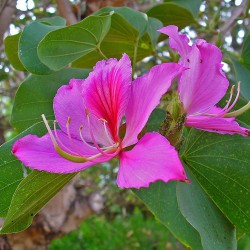
Orchid tree - mountain...
Price
€1.25
(SKU: T 91)
Seeds Gallery EU,
5/
5
<h2 class=""><strong>Orchid tree - mountain ebony seeds (Bauhinia variegata)</strong></h2>
<h2 style="color: #232323; font-size: 2rem;"><span style="color: #ff0000;"><strong>Price for Package of 5 seeds.</strong></span></h2>
<p style="color: #202122; font-size: 14px;"><i><b>Bauhinia variegata</b></i><span> </span>is a species of<span> </span>flowering plant<span> </span>in the legume family,<span> </span>Fabaceae. It is native to an area from China through<span> </span>Southeast Asia<span> </span>to the<span> </span>Indian subcontinent.<sup id="cite_ref-GRIN_2-0" class="reference" style="font-size: 11.2px;"></sup><span> </span>Common names include<span> </span><b>orchid tree</b><span> </span>(though not belonging to the family<span> </span>Orchidaceae) and<span> </span><b>mountain ebony</b>.</p>
<p>It is a small to medium-sized tree growing to 10–12 metres (33–39 ft) tall,<span> </span>deciduous<span> </span>in the<span> </span>dry season. The<span> </span>leaves<span> </span>are 10–20 centimetres (3.9–7.9 in) obcordate shaped, long and broad, rounded, and bilobed at the base and apex. The<span> </span>flowers<span> </span>are conspicuous, bright pink or white, 8–12 centimetres (3.1–4.7 in) diameter, with five petals. Pollens are elongated, approximately 75 microns in length.</p>
<p>The<span> </span>fruit<span> </span>is a<span> </span>seedpod<span> </span>15–30 centimetres (5.9–11.8 in) long, containing several<span> </span>seeds. The seedpod dries completely on the tree, and when mature begins to twist into a helix or corkscrew shape, (see<span> </span>below), ultimately exploding open—with a very audible "clack"—to deliver its seeds into the environs.</p>
<p>The anatomy of the stem was studied by taking transverse section. Periderm and cortex were seen distinctly. Secondary phloem was wide and continuous cylindrical, it consisted of thin and narrow straight rays, three or four cylinders of discontinuous masses of fibres and randomly distributed sieve elements. Secondary xylem was diffuse porous and it included vessels, fibres, xylem rays and xylem parenchyma. Xylem fibres had thick lignified walls or some had gelatinous walls. Xylem parenchyma cells were abundant in the xylem. Xylem rays were one cell wide; they were straight and consisted of radially elongated thick walled lignified walls. Calcium-oxalate crystals are predominantly prismatic crystals and druses type. Powder microscopical examination showed presence of fibres, parenchymatous cells, periderm and vessel elements. Histochemical analysis of stem showed presence of protein, tannin, lignin and cellulose.<sup id="cite_ref-3" class="reference" style="font-size: 11.2px;">[3]</sup></p>
<p>The anatomy of the root was studied by taking transverse section. Secondary phloem and secondary xylem were seen distinctly. Secondary phloem had fairly wide rays, dense masses of phloem fibers and radial rows of phloem elements. Secondary xylem had much wider, thin-walled vessels which were either solitary or in radial multiples. The xylem fibers constituted gelatinous type and normal type. Calcium oxalate crystals were predominantly prismatic type. Powder microscopical examination showed presence of xylem parenchyma cells, xylem fibers and vessel elements.<sup id="cite_ref-4" class="reference" style="font-size: 11.2px;"></sup></p>
<h2 style="color: #000000; font-size: 1.5em;"><span class="mw-headline" id="In_cultivation">In cultivation</span></h2>
<p>This is a very popular<span> </span>ornamental tree<span> </span>in subtropical and tropical climates, grown for its scented flowers and also used as a food item in<span> </span>Indian cuisine. In the<span> </span>Neotropics, it can be used to attract<span> </span>hummingbirds—such as<span> </span>sapphire-spangled emerald<span> </span>(<i>Amazilia lactea</i>),<span> </span>glittering-bellied emerald<span> </span>(<i>Chlorostilbon lucidus</i>), or<span> </span>white-throated hummingbird<span> </span>(<i>Leucochloris albicollis</i>)—into gardens and parks.<sup id="cite_ref-5" class="reference" style="font-size: 11.2px;"></sup><span> </span>On the other hand, in some areas it has become<span> </span>naturalised<span> </span>and<span> </span>invasive.</p>
<h2 style="color: #000000; font-size: 1.5em;"><span class="mw-headline" id="Uses">Uses</span></h2>
<p>Kachnar is a local name in the Indian subcontinent for the edible buds collected from the tree; it is widely used as an ingredient in many subcontinent recipes. Traditional kachnar curry is prepared using kachnar buds, yogurt, onions and native spices. Kachnar buds are also eaten as a stir-fried vegetable and used to make<span> </span>achaar, a pickle in many parts of the Indian sub-continent.<sup id="cite_ref-6" class="reference" style="font-size: 11.2px;"></sup><span> </span>It shows a good antioxidant and anticancer activity.</p>
<p style="color: #202122; font-size: 14px;"><br><sup id="cite_ref-GRIN_2-1" class="reference" style="font-size: 11.2px;"></sup></p>
<br><br>
<script src="//cdn.public.n1ed.com/G3OMDFLT/widgets.js"></script>
T 91 (5 S)

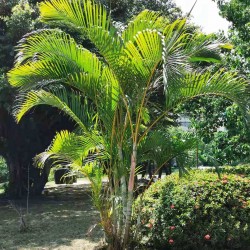
Golden cane palm seeds...
Price
€3.95
(SKU: PS 14)
Seeds Gallery EU,
5/
5
<h2><strong>Golden cane palm seeds (Dypsis lutescens)</strong></h2>
<h2><span style="color: #ff0000;"><strong>Price for Package of 3 seeds.</strong></span></h2>
<p><i style="color: #202122; font-size: 14px;"><b>Dypsis lutescens</b></i><span style="color: #202122; font-size: 14px;">, also known as<span> </span></span><b style="color: #202122; font-size: 14px;">golden cane palm</b><span style="color: #202122; font-size: 14px;">,<span> </span></span><b style="color: #202122; font-size: 14px;">areca<span> </span>palm</b><span style="color: #202122; font-size: 14px;">,</span><span style="color: #202122; font-size: 14px;"><span> </span></span><b style="color: #202122; font-size: 14px;">yellow palm</b><span style="color: #202122; font-size: 14px;">,</span><span style="color: #202122; font-size: 14px;"><span> </span>or<span> </span></span><b style="color: #202122; font-size: 14px;">butterfly palm</b><span style="color: #202122; font-size: 14px;">,</span><span style="color: #202122; font-size: 14px;"><span> </span>is a<span> </span></span>species<span style="color: #202122; font-size: 14px;"><span> </span>of<span> </span></span>flowering plant<span style="color: #202122; font-size: 14px;"><span> </span>in the<span> </span></span>family<span style="color: #202122; font-size: 14px;"><span> </span></span>Arecaceae<span style="color: #202122; font-size: 14px;">,<span> </span></span>native<span style="color: #202122; font-size: 14px;"><span> </span>to<span> </span></span>Madagascar<span style="color: #202122; font-size: 14px;"><span> </span>and naturalized in the<span> </span></span>Andaman Islands<span style="color: #202122; font-size: 14px;">,<span> </span></span>Réunion<span style="color: #202122; font-size: 14px;">,<span> </span></span>El Salvador<span style="color: #202122; font-size: 14px;">,<span> </span></span>Cuba<span style="color: #202122; font-size: 14px;">,<span> </span></span>Puerto Rico<span style="color: #202122; font-size: 14px;">, the<span> </span></span>Canary Islands<span style="color: #202122; font-size: 14px;">, southern<span> </span></span>Florida<span style="color: #202122; font-size: 14px;">,<span> </span></span>Haiti<span style="color: #202122; font-size: 14px;">, the<span> </span></span>Dominican Republic<span style="color: #202122; font-size: 14px;">,<span> </span></span>Jamaica<span style="color: #202122; font-size: 14px;">, the<span> </span></span>Leeward Islands<span style="color: #202122; font-size: 14px;"><span> </span>and the<span> </span></span>Leeward Antilles<span style="color: #202122; font-size: 14px;">.<br></span></p>
<p><i>Dypsis lutescens</i><span> </span>grows 6–12 m (20–39 ft) in height. Multiple stems emerge from the base. The fronds are arched, 2–3 m (6 ft 7 in–9 ft 10 in) long, and<span> </span>pinnate, with 40-60 pairs of leaflets. It bears<span> </span>panicles<span> </span>of yellow flowers in summer.<span> </span>Offsets<span> </span>can be cut off when mature enough, as a<span> </span>propagation<span> </span>method.</p>
<p>It is grown as an<span> </span>ornamental plant<span> </span>in gardens in tropical and subtropical regions, and elsewhere indoors as a<span> </span>houseplant. It has gained the<span> </span>Royal Horticultural Society's<span> </span>Award of Garden Merit.<sup id="cite_ref-4" class="reference" style="font-size: 11.2px;"></sup><sup id="cite_ref-5" class="reference" style="font-size: 11.2px;"></sup></p>
<p>One of several common names, "butterfly palm", refers to the leaves which curve upwards in multiple stems to create a butterfly look.<sup id="cite_ref-6" class="reference" style="font-size: 11.2px;">[6]</sup></p>
<div class="thumb tright">
<div class="thumbinner" style="font-size: 13.16px;"><img alt="Chrysalidocarpus lutescens (Dypsis lutescens).jpg" src="https://upload.wikimedia.org/wikipedia/en/thumb/9/90/Chrysalidocarpus_lutescens_%28Dypsis_lutescens%29.jpg/220px-Chrysalidocarpus_lutescens_%28Dypsis_lutescens%29.jpg" decoding="async" width="220" height="293" class="thumbimage" srcset="//upload.wikimedia.org/wikipedia/en/thumb/9/90/Chrysalidocarpus_lutescens_%28Dypsis_lutescens%29.jpg/330px-Chrysalidocarpus_lutescens_%28Dypsis_lutescens%29.jpg 1.5x, //upload.wikimedia.org/wikipedia/en/thumb/9/90/Chrysalidocarpus_lutescens_%28Dypsis_lutescens%29.jpg/440px-Chrysalidocarpus_lutescens_%28Dypsis_lutescens%29.jpg 2x" data-file-width="3000" data-file-height="4000" title="Golden cane palm seeds (Dypsis lutescens)">
<div class="thumbcaption" style="font-size: 12.3704px;">
<div class="magnify"></div>
</div>
</div>
</div>
<p>In its introduced range, this plant acts as a supplier of fruit to some bird species which feed on it opportunistically, such as<span> </span><i>Pitangus sulphuratus</i>,<span> </span><i>Coereba flaveola</i><span> </span>and<span> </span><i>Thraupis sayaca</i><span> </span>species in Brazil.</p>
<p><span style="color: #202122; font-size: 14px;"></span></p><script src="//cdn.public.n1ed.com/G3OMDFLT/widgets.js"></script>
PS 14 (3 S)


Super rare Carica papaya...
Price
€5.95
(SKU: V 22 GM)
Seeds Gallery EU,
5/
5
<h2 class=""><strong>Super rare Carica papaya Gabon Melon seeds</strong></h2>
<h2><span style="color: #ff0000;"><strong>Price for Package of 5 seeds.</strong></span></h2>
A rare papaya cultivar that is grown in central Africa. The plants produce large quantities of globose fruit nearly globose fruit that has an excellent flavor and texture.<br><br>Since this type of papaya does not grow tall (mini), it is great for growing in flower pots. It bears fruit as early as one year after sowing.
V 22 GM (5 S)


Medicinal or spice plant
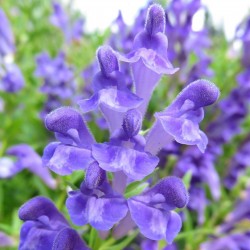
Baikal skullcap, Chinese...
Price
€2.35
(SKU: MHS 64)
Seeds Gallery EU,
5/
5
<h2><strong>Baikal skullcap, Chinese skullcap Seeds (Scutellaria baicalensis)</strong></h2>
<h2><span style="color: #ff0000;"><strong>Price for a Package of 10 seeds.</strong></span></h2>
<p><i><b>Scutellaria baicalensis</b></i>, with the common name<span> </span><b>Baikal skullcap</b><span> </span>or<span> </span><b>Chinese skullcap</b>, is a species of<span> </span>flowering plant<span> </span>in the family<span> </span>Lamiaceae. The plant is native to<span> </span>China,<span> </span>Korea,<span> </span>Mongolia, and Russia in the<span> </span>Russian Far East<span> </span>and<span> </span>Siberia.<sup id="cite_ref-grin_1-2" class="reference"></sup></p>
<h2><span class="mw-headline" id="Medicinal_plant">Medicinal plant</span></h2>
<h3><span class="mw-headline" id="Traditional_Chinese_medicine">Traditional Chinese medicine</span></h3>
<p>It is one of the<span> </span>50 fundamental herbs<span> </span>used in<span> </span>traditional Chinese medicine, where it has the name<span> </span><i>huángqín</i><span> </span>(Chinese:<span> </span><span lang="zh">黄芩</span>).<sup id="cite_ref-2" class="reference"></sup><span> </span>As a Chinese traditional medicine,<span> </span><i>huang qin</i><span> </span>usually refers to the dried root of<span> </span><i>S. baicalensis</i><span> </span>Georgi,<span> </span><i>S. viscidula</i><span> </span>Bge.,<span> </span><i>S. amoena</i><span> </span>C.H. Wright, and<span> </span><i>S. ikoninkovii</i><span> </span>Ju.</p>
<h3><span class="mw-headline" id="Pharmacology">Pharmacology</span></h3>
<div role="note" class="hatnote navigation-not-searchable">Main article:<span> </span>Scutellaria § Constituents and pharmacology</div>
<p>Several chemical compounds have been isolated from the root;<span> </span>baicalein,<span> </span>baicalin,<span> </span>wogonin,<span> </span>norwogonin,<span> </span>oroxylin A<span> , </span>and<span> </span>β-sitosterol<span> </span>are the major ones.<sup id="cite_ref-pmid12774393_4-0" class="reference"></sup></p>
<h3><span class="mw-headline" id="Names">Names</span></h3>
<p>It is important to use the Latin name, as the term 'skullcap' is used for over 200 varieties. Sometimes,<span> </span><i>Scutellaria lateriflora</i><span> </span>(North American skullcap) is mistaken for<span> </span><i>S. baicalensis</i>. This confusion can result in the intake of the<span> </span><i>S. lateriflora</i><span> </span>variety which can be processed and contaminated with other plants at high enough levels to be of concern</p>
MHS 64 (10 S)

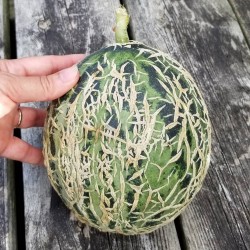
Casca de Carvalho Melon Seeds
Price
€2.10
(SKU: V 34)
Seeds Gallery EU,
5/
5
<meta http-equiv="Content-Type" content="text/html; charset=UTF-8" />
<h2><strong>Casca de Carvalho Melon Seeds</strong></h2>
<h2><span style="color: #ff0000;"><strong>Price for a Package of 10 seeds.</strong></span></h2>
<p>Very old rare Portuguese heirloom with an excellent taste and Oblong and rounded fruit with an average weight of 3 to 4 kg from the north of Portugal.</p>
<p>The skin is cream-colored with fine and dense lattice. The pulp is salmon pink, very sugary. This type of melon has a unique spicy flavor and it’s very juicy, which makes it a highly requested product in fairs and festivities. Therefore, its uniqueness makes this melon a product with a high level of commercialization.</p>
<p>Also known as "Écorce de chêne" because of its shell reminiscent of that of an oak.</p>
V 34 (10 S)

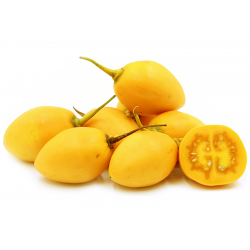
Yellow Tamarillo Seeds...
Price
€2.15
(SKU: V 159)
Seeds Gallery EU,
5/
5
<!DOCTYPE html>
<html>
<head>
<meta http-equiv="Content-Type" content="text/html; charset=UTF-8" />
</head>
<body>
<h2><strong>Yellow Tamarillo Seeds (Golden Tamarillo)</strong></h2>
<h2><span style="color: #ff0000;"><strong>Price for Package of 5 seeds.</strong></span></h2>
<p>It is still hard to find Yellow tamarillo seeds. Yellow tamarillo fruit is egg-shaped with a glossy tangerine hued skin and succulent flesh containing small soft edible seeds. The skin is thin and tannin-rich for palatable human consumption. Its flesh when is ripe is bright and piquant in flavor with a pleasantly sweet aroma.</p>
<p>The Golden tamarillo, botanical name Cyphomandra betacea, is also known as the tree tomato, is a member of the Solanaceae family which includes tomatoes, potatoes, tobacco, and pepper plants.</p>
<h2><strong>WIKIPEDIA:</strong></h2>
<div><span>The </span><b>tamarillo</b><span> is a small tree or </span>shrub<span> in the </span>flowering plant<span> family </span>Solanaceae<span> (the nightshade family). It is best known as the species that bears the </span><b>tamarillo</b><span>, an egg-shaped edible </span>fruit<span>.</span><span> It is also known as the </span><b>tree<span> </span>tomato</b><span>,</span><span> </span><b>tomate andino</b><span>, </span><b>tomate serrano</b><span>, </span><b>tomate de<span> </span>yuca</b><span>, </span><b>sachatomate</b><span>, </span><b>berenjena</b><span>, </span><b>tamamoro</b><span>, and </span><b>tomate de árbol</b><span> in South America.</span></div>
<div></div>
<div>
<h3><span class="mw-headline" id="Plant_origin_and_regions_of_cultivation">Plant origin and regions of cultivation</span></h3>
<p>The tamarillo is native to the Andes of Ecuador, Colombia, Peru, Chile, and Bolivia. Today it is still cultivated in gardens and small orchards for local production,<sup id="cite_ref-SmallFruitsReview_4-0" class="reference">[4]</sup> and it is one of the most popular fruits in these regions.<sup id="cite_ref-economicBotany_5-0" class="reference">[5]</sup> Other regions of cultivation are the subtropical areas throughout the world, such as Rwanda, South Africa, Darjeeling, and Sikkim in India, Nepal, Hong Kong, China, the United States, Australia, Bhutan, and New Zealand.</p>
<p>The first internationally marketed crop of tamarillos in Australia was produced around 1996, although permaculture and exotic fruit enthusiasts had increasingly grown the fruit around the country from the mid-1970s on.</p>
<p>In New Zealand, about 2,000 tons are produced on 200 hectares of land and exported to the United States, Japan, and Europe. For the export, the existing marketing channels developed for the kiwifruit are used.</p>
<p>The tamarillo is also successfully grown at higher elevations of Malaysia and the Philippines, and in Puerto Rico. In the hot tropical lowlands, it develops only small fruits and fruit setting is seldom.</p>
<p>Prior to 1967, the tamarillo was known as the "tree<span> </span>tomato" in New Zealand, but a new name was chosen by the New Zealand Tree<span> </span>Tomato<span> </span>Promotions Council in order to distinguish it from the ordinary garden tomatoand increase its exotic appeal.</p>
</div>
<h3><span class="mw-headline" id="Plant">Plant</span></h3>
<div class="thumb tright">
<div class="thumbinner"><img alt="" src="https://upload.wikimedia.org/wikipedia/commons/thumb/3/31/Cyphomandra_betacea1.jpg/220px-Cyphomandra_betacea1.jpg" width="220" height="165" class="thumbimage" data-pagespeed-url-hash="2010095046" onload="pagespeed.CriticalImages.checkImageForCriticality(this);" />
<div class="thumbcaption">
<div class="magnify"></div>
Flower cluster</div>
</div>
</div>
<p>The plant is a fast-growing tree that grows up to 5 meters. Peak production is reached after 4 years,<sup id="cite_ref-LostCrops_6-1" class="reference">[6]</sup> and the life expectancy is about 12 years.<sup id="cite_ref-SmallFruitsReview_4-3" class="reference">[4]</sup> The tree usually forms a single upright trunk with lateral branches. The flowers and fruits hang from the lateral branches. The leaves are large, simple and perennial, and have a strong pungent smell.<sup id="cite_ref-LostCrops_6-2" class="reference">[6]</sup> The flowers are pink-white and form clusters of 10 to 50 flowers. They produce 1 to 6 fruits per cluster. Plants can set fruit without cross-pollination, but the flowers are fragrant and attract insects. Cross-pollination seems to improve fruit set.<sup id="cite_ref-LostCrops_6-3" class="reference">[6]</sup> The roots are shallow and not very pronounced, therefore the plant is not tolerant of drought stress and can be damaged by strong winds. Tamarillos will hybridize with many other<span> </span>Solanaceae, though the hybrid fruits will be sterile, and unpalatable in some instances.</p>
<h3><span class="mw-headline" id="Fruit">Fruit</span></h3>
<div class="thumb tright">
<div class="thumbinner"><img alt="" src="https://upload.wikimedia.org/wikipedia/commons/thumb/9/9a/Solanum_betaceum_unripe_fruits.jpg/220px-Solanum_betaceum_unripe_fruits.jpg" width="220" height="146" class="thumbimage" data-pagespeed-url-hash="2489475574" onload="pagespeed.CriticalImages.checkImageForCriticality(this);" />
<div class="thumbcaption">
<div class="magnify"></div>
Unripe fruits</div>
</div>
</div>
<div class="thumb tright">
<div class="thumbinner"><img alt="" src="https://upload.wikimedia.org/wikipedia/commons/thumb/0/00/Tamarillos%28janek2005%29.jpg/220px-Tamarillos%28janek2005%29.jpg" width="220" height="182" class="thumbimage" data-pagespeed-url-hash="1269263135" onload="pagespeed.CriticalImages.checkImageForCriticality(this);" />
<div class="thumbcaption">
<div class="magnify"></div>
Ripe fruits</div>
</div>
</div>
<p>The fruits are egg-shaped and about 4-10 centimeters long. Their color varies from yellow and orange to red and almost purple. Sometimes they have dark, longitudinal stripes. Red fruits are more acetous, yellow and orange fruits are sweeter. The flesh has a firm texture and contains more and larger seeds than a common tomato.<sup id="cite_ref-SmallFruitsReview_4-4" class="reference">[4]</sup> The fruits are very high in vitamins and iron and low in calories (only about 40 calories per fruit).</p>
<h3><span class="mw-headline" id="Soil_and_climate_requirements">Soil and climate requirements</span></h3>
<p>The tamarillo prefers a subtropical climate, with rainfall between 600 and 4000 millimeters and annual temperatures between 15 and 20 °C.<sup id="cite_ref-SmallFruitsReview_4-6" class="reference">[4]</sup> It is intolerant to frost (below -2 °C) and drought stress. It is assumed that the fruit set is affected by night temperatures. Areas, where citrus is cultivated, provide good conditions for tamarillos as well, such as in the Mediterranean climate. Tamarillo plants grow best in light, deep, fertile soils, although they are not very demanding. However, soils must be permeable since the plants are not tolerant of water-logging.<sup id="cite_ref-SmallFruitsReview_4-7" class="reference">[4]</sup> They grow naturally on soils with a pH of 5 to 8.5.</p>
<h3><span class="mw-headline" id="Growth">Growth</span></h3>
<p>Propagation is possible by both using seeds or cuttings.<sup id="cite_ref-SmallFruitsReview_4-8" class="reference">[4]</sup><sup id="cite_ref-7" class="reference">[7]</sup> Seedlings first develop a straight, about 1.5 to 1.8 meters tall trunk, before they branch out. Propagation by seeds is easy and ideal in protected environments. However, in orchards with different cultivars, cross-pollination will occur and the characteristics of the cultivars get mixed up. Seedlings should be kept in the nursery until they reach a height of 1 to 1.5 meters, as they are very frost-sensitive.</p>
<p>Plants grown from cuttings branch out earlier and result in more shrub-like plants that are more suitable for exposed sites. Cuttings should be made from basal and aerial shoots and should be free of pathogenic viruses. Plants grown from cuttings should be kept in the nursery until they reach a height of 0.5 to 1 meter.</p>
<p>The tree grows very quickly and is able to bear fruit after 1.5 to 2 years. The plant is daylength-insensitive. The fruits do not mature simultaneously unless the tree has been pruned. A single tree can produce more than 20 kg of fruit per year; an orchard yields in 15 to 17 tons per hectare.<sup id="cite_ref-LostCrops_6-5" class="reference">[6]</sup> One single mature tree in good soil will bear more fruit than a typical family can eat in about 3 months.</p>
<p>Tamarillos are suitable for growing as indoor container plants, though their swift growth, their light, water, and humidity requirements, and their large leaves can pose a challenge to those with limited space.</p>
<h3><span class="mw-headline" id="Plant_management">Plant management</span></h3>
<div class="thumb tright">
<div class="thumbinner"><img alt="" src="https://upload.wikimedia.org/wikipedia/commons/thumb/0/0a/Cyphomandra_betacea2.jpg/220px-Cyphomandra_betacea2.jpg" width="220" height="293" class="thumbimage" data-pagespeed-url-hash="353362248" onload="pagespeed.CriticalImages.checkImageForCriticality(this);" />
<div class="thumbcaption">
<div class="magnify"></div>
Tamarillo tree</div>
</div>
</div>
<p>The tamarillo trees are adaptable and very easy to grow. However, some plant management strategies can help to stabilize and improve plant performance.</p>
<h4><span class="mw-headline" id="Planting">Planting</span></h4>
<p>Planting distances depend on the growing system. In New Zealand, with mechanized production, single row planting distances of 1 to 1.5 meters between plants and 4.5 to 5 meters between rows are recommended. In traditional growing regions such as the Andean region, plantations are much denser, with 1.2 to 1.5 meters between plants. Dense planting can be a strategy to protect plants against the wind. On poorly drained soils, plants should be planted on ridges.</p>
<h4><span class="mw-headline" id="Pruning">Pruning</span></h4>
<p>Pruning can help to control fruit size, plant size, harvest date and to simplify the harvesting of fruits.<sup id="cite_ref-SmallFruitsReview_4-10" class="reference">[4]</sup> Cutting the tip of young plants leads to the desired branch height. Once the tree shape has been formed, pruning is reduced to the removal of old or dead wood and previously fruited branches, since branches that have already carried fruits will produce smaller fruits with lower quality the next time. Light pruning leads to medium-sized, heavy pruning to large-sized fruits. Basal shoots should be removed. When plants are grown in greenhouses, pruning prevents excessive vegetative growth.</p>
<p>When the tree is about 1 to 1.5 meters in height, it is advisable to cut the roots on one side and lean the tree to the other (in the direction of the midday sun at about 30 to 45 degrees). This allows fruiting branches to grow all along the trunk rather than just at the top.</p>
<div class="thumb tright">
<div class="thumbinner"><img alt="" src="https://upload.wikimedia.org/wikipedia/commons/thumb/e/e3/Tamarillo_seedlings%2C_6_months_old.jpg/220px-Tamarillo_seedlings%2C_6_months_old.jpg" width="220" height="215" class="thumbimage" data-pagespeed-url-hash="1025451796" onload="pagespeed.CriticalImages.checkImageForCriticality(this);" />
<div class="thumbcaption">
<div class="magnify"></div>
Tamarillo seedlings, 6 months old</div>
</div>
</div>
<h4><span class="mw-headline" id="Mulching">Mulching</span></h4>
<p>Since the plants are sensitive to drought stress, mulching can help to preserve moisture in the soil.<sup id="cite_ref-LostCrops_6-6" class="reference">[6]</sup> It can also be a strategy to suppress weeds, as other soil management techniques, such as plowing, are not possible due to the shallow and sensitive root system.</p>
<h4><span class="mw-headline" id="Shelter">Shelter</span></h4>
<p>The plants have to be protected from the wind. Their shallow root system does not provide enough stability, and the lateral branches are fragile and break easily when carrying fruits.<sup id="cite_ref-SmallFruitsReview_4-11" class="reference">[4]</sup></p>
<h4><span class="mw-headline" id="Irrigation_and_fertilization">Irrigation and fertilization</span></h4>
<p>To maximize and stabilize production, water, and nutrient inputs should be provided when needed. The plants need a continuous supply of water due to their shallow root system. Drought stress results in a decrease in plant growth, fruit size, and productivity.<sup id="cite_ref-SmallFruitsReview_4-12" class="reference">[4]</sup> Recommended fertilizer rates per hectare are 170 kg of Nitrogen, 45 kg of Phosphorus, and 130 to 190 kg of Potassium for intensive New Zealand production systems. Phosphorus and Potassium are applied at the beginning of the season, Nitrogen applications are distributed throughout the year.</p>
<h4><span class="mw-headline" id="Pest_management">Pest management</span></h4>
<p>The tamarillo tree is, compared to similar crops such as tomatoes, quite resistant to pests in general. Still, to reduce risk in intensive production systems, some pests have to be controlled to avoid major crop damage. To control pests, the same control methods as other Solanaceae can be used.</p>
<h3><span class="mw-headline" id="Harvest">Harvest</span></h3>
<p>Ripening of fruits is not simultaneous. Several harvests are necessary.<sup id="cite_ref-8" class="reference">[8]</sup> In climates with little annual variation, tamarillo trees can flower and set fruit throughout the year. In climates with pronounced seasons (such as New Zealand), fruits ripen in autumn. Premature harvest and ethylene-induced ripening in controlled-atmosphere chambers are possible with minimal loss of fruit quality.<sup id="cite_ref-Ripening_9-0" class="reference">[9]</sup> The fragile lateral branches can break easily when loaded with fruits, so premature harvest helps to reduce this risk and allows storage of fruits up to 20 days at room temperature. A cold-water dipping process, developed by the New Zealand Department of Scientific and Industrial Research also allows further storage of 6–10 weeks.</p>
<h2><span class="mw-headline" id="Usage">Usage</span></h2>
<h3><span class="mw-headline" id="Culinary_use">Culinary use</span></h3>
<p>The fruit is eaten by scooping the flesh from a halved fruit. When lightly sugared and cooled, the flesh is used for a breakfast dish. Some people in New Zealand cut the fruit in half, scoop out the pulpy flesh and spread it on toast at breakfast. Yellow-fruited cultivars have a sweeter flavor, occasionally compared to mango or apricot. The red-fruited variety, which is much more widely cultivated, is more tart, and the savory aftertaste is far more pronounced. In the Northern Hemisphere, tamarillos are most frequently available from July until November, and fruits early in the season tend to be sweeter and less astringent.</p>
<p>They can be made into compotes, or added to stews (e.g. Boeuf Bourguignon), hollandaise, chutneys, and curries. Desserts using this fruit include bavarois and, combined with apples, a strudel.</p>
<p>Tamarillos can be added as a secondary fermentation flavoring to Kombucha Tea for a tart and tangy taste. The fruit should be mashed and added at a ratio of 3 Tamarillos to 1 Litre of Kombucha, however, great care should be taken to not allow too much carbon dioxide gas to build up in sealed bottles during secondary fermentation. The sugar content of fresh Tamarillos added to Kombucha can generate rapid carbon dioxide production in secondary fermentation within just 48–72 hours.</p>
<p>In Colombia, Ecuador, Panama, and parts of Indonesia (including Sumatra and Sulawesi), fresh tamarillos are frequently blended together with water and sugar to make a juice. It is also available as a commercially pasteurized purée.</p>
<p>In Nepal, a version of the South American fruit is decently popular. It is typically consumed as a chutney or a pickle during the autumn and winter months. It is known as <i>Tammatar</i> and <i>Ram Bheda</i>. Similar to Nepal, the Indian regions of Ooty, Darjeeling, and Sikkim also consume Tamarillo.</p>
<p>In Ecuador, the tamarillo, known as <i>tomate de árbol</i>, is blended with chili<span> </span>peppers<span> </span>to make a hot sauce commonly consumed with local dishes of the Andean region. The sauce is simply referred to as <i>aji</i> and is present at every meal in Ecuador.</p>
<p>The flesh of the tamarillo is tangy and variably sweet, with a bold and complex flavor, and maybe compared to kiwifruit,<span> </span>tomato, guava, or passion fruit. The skin and the flesh near it have a bitter taste and are not usually eaten raw</p>
<p>The tamarillo has been described as having a taste similar to that of a passion fruit and a piquant tomato combined.</p>
<p>The red and purple types of fruits are preferred in import countries of Europe: Even though they taste more acidic, their color is favored by consumers.</p>
<h3><span class="mw-headline" id="Industrial_use">Industrial use</span></h3>
<p>The fruits are high in pectin and therefore have good properties for preserves. However, they oxidize and lose color when not treated. Yellow fruit types are better suited for industrial use.</p>
<h2><span class="mw-headline" id="Prospects">Prospects</span></h2>
<p>Research and breeding should improve plantation management, fruit quality, and postharvest treatment.<sup id="cite_ref-LostCrops_6-7" class="reference">[6]</sup> A better understanding of plant physiology, nutritional requirements of plants, and fruit set mechanisms will help to improve growing systems. Breeding goals are to break seed dormancy, to improve the sweetness of fruits, and to increase yield. For industrial uses, little "stones" of sodium and calcium that occasionally appear in the fruit skin form a problem. Those stones have to be eliminated by breeding.</p>
</body>
</html>
V 159 (5 S)


Variety from Serbia

Plant resistant to cold and frost
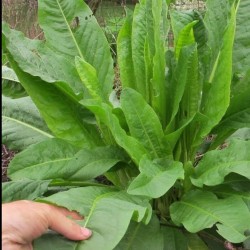
Herb patience, monk's...
Price
€2.45
(SKU: VE 210)
Seeds Gallery EU,
5/
5
<h2><strong>Herb patience, monk's rhubarb seeds (Rumex patientia)</strong></h2>
<h2><span style="color: #ff0000;" class=""><strong>Price for Package of 100 seeds.</strong></span></h2>
<p>Rumex patientia, known as patience dock, garden patience, herb patience, or monk's rhubarb, is a herbaceous perennial plant species of the genus Rumex, belonging to the family Polygonaceae. In spring it is often consumed as a leaf vegetable in Southern Europe, especially in Bulgaria, North Macedonia, and Serbia. It is also used in Romania in spring broths or sarmale.</p>
<p>The leaves are known and highly valued in traditional cuisine, can be eaten raw or cooked, but do contain oxalic acid, so should not be eaten in excess (e.g. every day). The leaves can be used raw in salads, cooked in soups and stews, or layered in baked dishes like lasagna. The leaves are high in minerals and can be harvested at any time.</p>
<p>Consumption of Rumex patientia stimulates mental and physical energy while being a barrier against bacteria that cause tooth decay, these qualities are supported by scientific research and studies.</p>
<p>Plant with an erect stem, reaching 140 cm in height. The stem is thick, grooved, branching in the upper part.</p>
<p>During the vegetation, it is harvested 2-3 times. In conditions of irrigation and feeding, it can grow in the same place for 3-4 years. It is suitable for growing in a protected area and in the open field.</p>
<p>The lower leaves are oblong-lanceolate or ovate, with pointed or obtuse ends, ranging in size from 10 to 35 cm in length and 5-10 cm in width. groove on top. The upper leaves are relatively small, planted on short petioles, with lanceolate plates.</p>
<p>The flowers are collected in a dense paniculate inflorescence formed by floral whorls of 10-16 flowers that make up leafless racemes. In the lower part of the pedicels, there are thickened joints.</p>
<script src="//cdn.public.n1ed.com/G3OMDFLT/widgets.js"></script>
VE 210 (100 S)

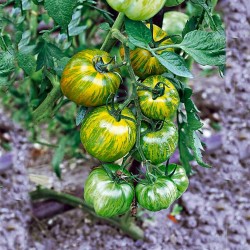
Smarald tomato seeds
Price
€2.25
(SKU: VT 97)
Seeds Gallery EU,
5/
5
<!DOCTYPE html>
<html>
<head>
<meta http-equiv="Content-Type" content="text/html; charset=UTF-8" />
</head>
<body>
<h2><strong>Smarald tomato seeds</strong></h2>
<h2><span style="color: #ff0000;"><strong>Price for Package of 10 seeds.</strong></span></h2>
<p>In our opinion, Smarald tomato is definitely an ornament in every garden. It's beautifully round fruits reach a weight of 150 to 200 grams on average. The fruits are light green in color, streaked with dark green when they are not ripe, as the fruits ripen they turn yellow and are streaked with dark green. The fruits have a pleasantly sweet and tonic taste.</p>
<p>The plants are strong, indeterminate, and reach an average height between 150 and 200 centimeters.</p>
<p>Great variety for fresh use, salads, sandwiches as well as for cooking.</p>
</body>
</html>
VT 97 (10 S)

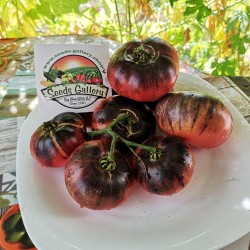
Blue Beauty Beefsteak...
Price
€1.90
(SKU: VT 53)
Seeds Gallery EU,
5/
5
<h2><strong>Blue Beauty Beefsteak Tomato Seeds</strong></h2>
<h2><span style="color: #ff0000;"><strong>Price for Package of 10 seeds.</strong></span></h2>
<p>The Indigo Blue Beauty tomato is a large beefsteaks-type tomato, characterized by its dense and meaty texture. They are overall round in shape with a slightly flattened figure, averaging four to eight ounces in size. Their interior flesh is orange-pink with small seed pockets, and their skin is a deep red color with the signature indigo-blushed highlights on their shoulders, or wherever the fruits receive maximum sun exposure. They are a sweet and richly flavorful tomato with low to moderate acid levels. The indeterminate Indigo Blue Beauty tomato plants continue to grow, flower, set fruit, and ripen throughout the growing season on long vines, which often require caging or staking. This productive variety is sunburn and crack resistant, and the fruits are known to hold well on the vine for an extended period of time.</p>
<p><strong>Current Facts</strong><br>Indigo Blue Beauty tomatoes are the largest of tomatoes in the Indigo series. “Indigo” was originally trademarked by Oregon State University, however the application was suspended and the trademark is now considered dead. Tomatoes, originally termed Solanum lycopersicum, are botanically referred to as Lycopersicon esculentum, although modern studies support a return to their original classification. Like the potato and eggplant, the tomato is a member of the Solanaceae, or nightshade, family.</p>
<p><strong>Ethnic/Cultural Info</strong><br>The Indigo series is a class of open-pollinated and hybrid tomatoes that have great taste are bred to include high levels of anthocyanin, a powerful antioxidant with disease fighting properties. Dr. Jim Myers of Oregon State University pioneered this class of tomato with the Indigo Rose, introduced to the market in 2011. Oregon State University and other independent breeders, notably Brad Gates of Wild Boar Farms, who is known in the California Bay Area as “the tomato guy”, have since developed other cultivars in the Indigo series using conventional breeding techniques. The focus of this breeding work has been to combine unusual and attractive color, traditional beloved heirloom tomato flavor, and antioxidant properties, which all in all has made tomatoes in this series unique and popular in the market place.</p>
<p><strong>Geography/History</strong><br>The Indigo Blue Beauty tomato was developed by Brad Gates of Wild Boar Farms, and was a selection of a cross between a beauty king and a blue tomato. Tomatoes are not at all hardy cultivars. They need warm weather to grow well, and they cannot stand any frost, so it is important that they be planted only after the danger of frost is gone.</p><script src="//cdn.public.n1ed.com/G3OMDFLT/widgets.js"></script>
VT 53 (10 S)


Giant plant (with giant fruits)

Variety from Hungary
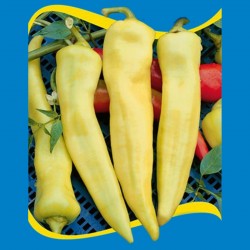
Sweet Pepper Seeds Feher Kos
Price
€2.15
(SKU: PP 16)
Seeds Gallery EU,
5/
5
<meta http-equiv="Content-Type" content="text/html; charset=UTF-8" />
<h2><strong>Sweet Pepper Seeds Feher Kos</strong></h2>
<h2><span style="color: #ff0000;"><strong>Price for Package of 10 seeds.</strong></span></h2>
<p>Hungarian Sweet Pepper variety Feher Kos is definitely one of our favorites, very large (up to 28 cm long), super sweet, crunchy, ideal for fresh use, and pickling. We love it fresh in salads or sandwiches. It is also ideal for making "Lucena paprika" salad.</p>
<p>We recommended this variety for open field cultivation and early foil growing (but it will also grow in pots without problems). The plant is <strong>very strong highly productive</strong> and we had no problems with diseases (and we use only organic compost, without any Chemical preparations for protection against diseases).</p>
<p>Its fruit is drooping, 22-25 cm long, with curved milky-white fruits (when the fruits are ripe becomes red color), sweet taste, and pointed tips.</p>
<p>It is excellent for raw consumption and pickling.</p>
PP 16 (10 S)


Giant plant (with giant fruits)

Plant resistant to cold and frost
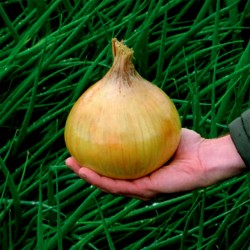
Goliath Giant Onion Seeds
Price
€1.95
(SKU: MHS 155)
Seeds Gallery EU,
5/
5
<meta http-equiv="Content-Type" content="text/html; charset=UTF-8" />
<h2><strong>Goliath Giant Onion Seeds</strong></h2>
<h2><strong><span style="color: #ff0000;">Price for a Package of 20 seeds.</span></strong></h2>
<p>A highly productive variety that can be grown from seed. Its breeding time is long. Its bulbs grow very large, so they require a more growing area. The taste is pleasantly sweet, not pungent.</p>
<p>It has a low dry matter content, a spherical onion, and light brown skin. It is suitable for fresh consumption and for making salads, it cannot be stored for a long time.</p>
<header class="page-header">
<div class="section-title">
<h2 class="page-title"><strong>How to grow onions and leeks</strong></h2>
<h1 class="page-title"><strong style="font-size: 14px;">Onions</strong></h1>
<p class="page-title">Italian onions are long-day onions. That means that they do best at higher latitudes (above 37 degrees or so — north of a line from southern Virginia to San Francisco). While you can direct seed in the early spring, you will get the largest bulbs if you grow your own onion seedlings. However, some varieties have done very well from direct seeding in our trial gardens. Follow these simple techniques for perfect Italian onions.</p>
</div>
</header>
<section class="section">
<div class="container container-small">
<article class="page-content cms-page">
<p><span><strong>For Transplants:</strong> </span><span> Start your seedlings 10-12 weeks before the time you plan to set them out. You can set them out in the early spring about two or three weeks before the last frost date.</span></p>
<p><span>To start your seedlings, put a growing mix (either store-bought or homemade from 1/2 finely sifted peat, 1/2 finely sifted compost, and 1/2 handful of lime per bushel of mix) about 4 inches deep in a flat. Wet mixture thoroughly. Put your onion seed on top trying to space the seeds about 1/4 to 1/2 inch apart. Cover with 1/4 inch soil mix or preferably vermiculite. Water again & set seeds in a warm place. As soon as they germinate, get them under grow lights. You can begin to feed them a week or so after they have germinated. </span></p>
<p><span>You want them to have plenty of space, so pull and discard any seedlings that are more than about 1/2 inch from the next one. Allow keeping growing. If they begin to get too tall, you can give them a 'haircut' with scissors. Just snip off the top inch or two of the seedlings. They will do fine.</span></p>
<p><span>About a week to ten days before you plan to set them out, begin to harden them off by putting them outside in a sheltered place for a few hours. Increase the time every day. </span></p>
<p><span>To plant out, have a well-dug bed with good fertility. Onions benefit from the soil with high phosphorus content. Plant them about three inches apart in rows set about 10 inches apart. Keep well watered throughout the growing season. Onions benefit from good fertile soil, so give your crop several side dressings.</span></p>
<p><span><strong>GROWING YOUR OWN ONION SETS. </strong></span><span>This is really easy and makes life easier next spring. Sow your seed for onion sets about three-four months before your expected hard frost. Prepare a nice bed. Add some good compost or 10-10-10 if you do not have any. Rake well. Scatter your onion seeds and try and get them about 1/4 inch apart. Firm them down by hand and cover with 1/4 inch soil. Keep well watered until they germinate and provide supplemental irrigation. Just let them grow. The tops will die back about the time the first frost is due. After the first good frost, pull your onions, which should be about the size of a marble. Store them in a cool dry place for a few weeks until they dry well. Don't wash off any dirt. Once well dried, pack them in mesh bags (save your old store-bought onion bags). Don't put too many in a bag; try about one pound per bad so that there is good air circulation. Store over the winter in a cool dry place.</span></p>
<p> </p>
<p><span><strong>GROWING ONION FROM SEEDS. </strong></span><span> In the north, direct seed in a well-prepared bed about four weeks before the last frost date. Try and get your onion seeds at least an inch apart. You can either leave them on the surface or cover them with 1/4 inch or so of soil (better). Onions should germinate in two weeks or so, perhaps earlier depending on the weather. Keep them well watered. </span></p>
<p><span>Once they have germinated and grown to three or four inches, you can begin to start thinning them out. Leave at least an inch between onions. Pull any weeds. Weeds will be the biggest problem you have grown from seed. </span></p>
<p><span>Barletta onions will be ready in early July, just in time to have them with the last of the spring peas. Other onions will be ready in August and September.</span></p>
<p> </p>
<p><span><strong>LEEKS</strong> </span></p>
<p><span>Grow your seedlings just like onions. The only difference is planting out. Make a trench about four inches deep with your hoe. Plant the leeks inside the trench. As the leeks grow, push soil into the trench up against the leek. When you run out of the trench, begin to mound up soil against the leeks. You want at least six inches of the plant buried under the soil. This is what is going to give you that nice white root. Begin harvesting after the first frost. Most leeks are incredibly cold hardy. In zones 7 on up, you can just leave them. Further North, cover them with some mulch (leaves, straw, etc) before the first hard freeze and you can harvest them all winter.</span></p>
</article>
</div>
</section>
MHS 155 (20 S)


Variety from Hungary
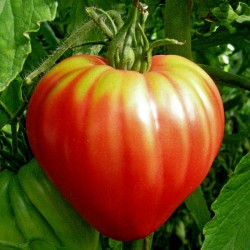
Hungarian Pink Ox-heart...
Price
€1.75
(SKU: VT 134)
Seeds Gallery EU,
5/
5
<!DOCTYPE html>
<html>
<head>
<meta http-equiv="Content-Type" content="text/html; charset=UTF-8" />
</head>
<body>
<h2><strong>Hungarian Pink Ox-heart Tomato Seeds</strong></h2>
<h2><span style="color: #ff0000;"><strong>Price for Package of 10 seeds.</strong></span></h2>
<p>The Hungarian ox-heart tomato is a heart-shaped, crimson, large, excellent-tasting, fleshy, thin-skinned tomato. The fruit can weigh up to 500 g. It has very strong growth, constantly growing, medium ripening.</p>
<p>It is one of the favorite tomatoes variety in Hungary for both fresh consumption and canning.</p>
<p>Home garden variety, member of an old Hungarian variety group.</p>
<p>Its large fruit is slightly sensitive.</p>
</body>
</html>
VT 134 (10 S)


Variety from Hungary
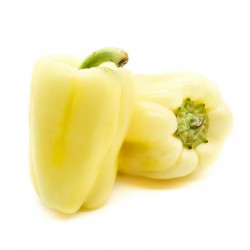
Hungarian Sweet Pepper...
Price
€1.85
(SKU: PP 23)
Seeds Gallery EU,
5/
5
<meta http-equiv="Content-Type" content="text/html; charset=UTF-8" />
<h2><strong>Hungarian Sweet Pepper Seeds Albaregia</strong></h2>
<h2><span style="color: #ff0000;"><strong>Price for Package of 20 seeds.</strong></span></h2>
<p>Hungarian high-yielding early-ripening sweet pepper variety, which is more resistant than the basic variety due to biodynamic cultivation. Albaregia is a typical field sweet pepper.</p>
<p>The white fruit ripens to orange-red. Its fruit is large (8 cm <span>in diameter and 12 cm long)</span>, erect, sweet, slightly ribbed, with an average weight of 170g, thick-skinned, delicious. Excellent for fresh consumption and to be stuffed.</p>
PP 23 (20 S)





